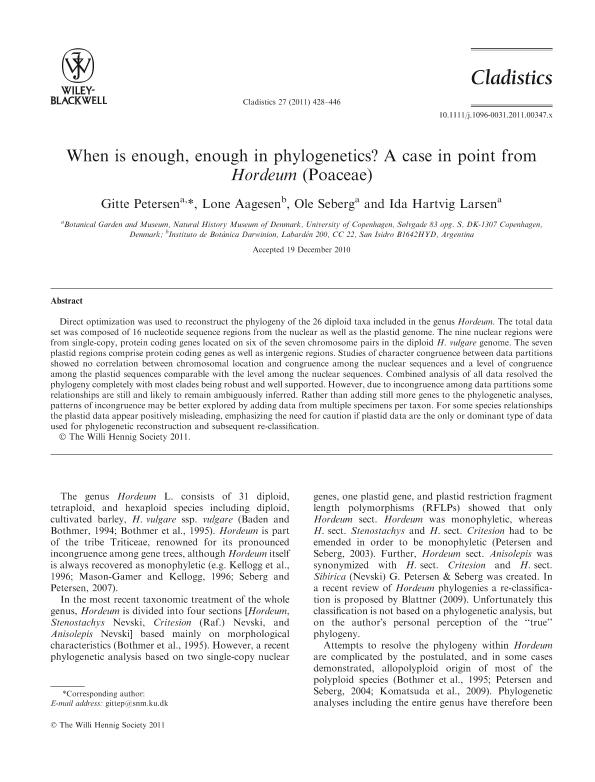Artículo
When is enough, enough in phylogenetics? A case in point from Hordeum (Poaceae)
Fecha de publicación:
08/2011
Editorial:
Wiley Blackwell Publishing, Inc
Revista:
Cladistics
ISSN:
0748-3007
Idioma:
Inglés
Tipo de recurso:
Artículo publicado
Clasificación temática:
Resumen
Direct optimization was used to reconstruct the phylogeny of the 26 diploid taxa included in the genus Hordeum. The total data set was composed of 16 nucleotide sequence regions from the nuclear as well as the plastid genome. The nine nuclear regions were from single-copy, protein coding genes located on six of the seven chromosome pairs in the diploid H. vulgare genome. The seven plastid regions comprise protein coding genes as well as intergenic regions. Studies of character congruence between data partitions showed no correlation between chromosomal location and congruence among the nuclear sequences and a level of congruence among the plastid sequences comparable with the level among the nuclear sequences. Combined analysis of all data resolved the phylogeny completely with most clades being robust and well supported. However, due to incongruence among data partitions some relationships are still and likely to remain ambiguously inferred. Rather than adding still more genes to the phylogenetic analyses, patterns of incongruence may be better explored by adding data from multiple specimens per taxon. For some species relationships the plastid data appear positively misleading, emphasizing the need for caution if plastid data are the only or dominant type of data used for phylogenetic reconstruction and subsequent re-classification.
Palabras clave:
Phylogeny
,
Hordeum
,
Direct Optimization
Archivos asociados
Licencia
Identificadores
Colecciones
Articulos(IBODA)
Articulos de INST.DE BOTANICA DARWINION (I)
Articulos de INST.DE BOTANICA DARWINION (I)
Citación
Petersen, Gitte; Aagesen, Lone; Seberg, Ole; Larsen, Ida Hartvig; When is enough, enough in phylogenetics? A case in point from Hordeum (Poaceae); Wiley Blackwell Publishing, Inc; Cladistics; 27; 4; 8-2011; 428-446
Compartir
Altmétricas




